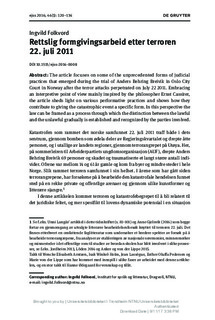| dc.contributor.author | Folkvord, Ingvild | |
| dc.date.accessioned | 2017-11-29T08:02:58Z | |
| dc.date.available | 2017-11-29T08:02:58Z | |
| dc.date.created | 2016-01-17T18:20:46Z | |
| dc.date.issued | 2016 | |
| dc.identifier.citation | European Journal of Scandinavian Studies. 2016, 46 (1), 120-136. | nb_NO |
| dc.identifier.issn | 2191-9399 | |
| dc.identifier.uri | http://hdl.handle.net/11250/2468324 | |
| dc.description.abstract | The article focuses on some of the unprecedented forms of judicial practices that emerged during the trial of Anders Behring Breivik in Oslo City Court in Norway after the terror attacks perpetrated on July 22 2011. Embracing an interpretive point of view mainly inspired by the philosopher Ernst Cassirer, the article sheds light on various performative practices and shows how they contribute to giving the catastrophic event a specific form. In this perspective the law can be framed as a process through which the distinction between the lawful and the unlawful gradually is established and recognized by the parties involved. | nb_NO |
| dc.language.iso | nob | nb_NO |
| dc.publisher | De Gruyter | nb_NO |
| dc.title | Rettslig formgivingsarbeid etter terroren 22. juli 2011 | nb_NO |
| dc.type | Journal article | nb_NO |
| dc.type | Peer reviewed | nb_NO |
| dc.description.version | publishedVersion | nb_NO |
| dc.source.pagenumber | 120-136 | nb_NO |
| dc.source.volume | 46 | nb_NO |
| dc.source.journal | European Journal of Scandinavian Studies | nb_NO |
| dc.source.issue | 1 | nb_NO |
| dc.identifier.doi | 10.1515/ejss-2016-0008 | |
| dc.identifier.cristin | 1315145 | |
| dc.description.localcode | © 2016 Walter de Gruyter GmbH, Berlin/Boston. | nb_NO |
| cristin.unitcode | 194,62,60,0 | |
| cristin.unitname | Institutt for språk og litteratur | |
| cristin.ispublished | true | |
| cristin.fulltext | original | |
| cristin.qualitycode | 2 | |
